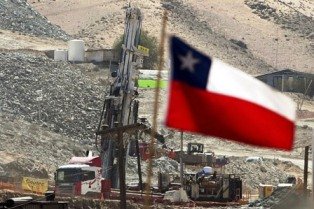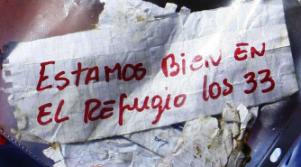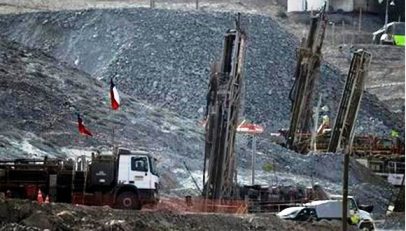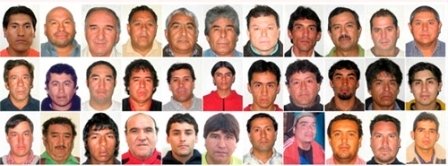|
The San Jose, Chile Miners
On August 5 2010 33 miners went to work in a mine called San Jose in Copiapo Chile. The Chile miners went 700 meters (2,300 ft) underground when all of a sudden the entrance way collapsed leaving them trapped. The family members immediately started to camp outside the mine in hope that their love ones where still alive. The camp ground was even named Campo Esperanza which means camp hope. Praying to the saints and to God, they never lost hope. The authorities found out about this, gathered at the mine and started drilling a hole down to where the miners were. The government took full responsibility for the Chile miners rescue since the mine company didn’t have enough funds to pay for the rescue. They weren’t sure exactly where they would find the miners, or if they would, because they were using some old blue prints of the mine that weren’t accurate. On August 12 there was another collapse of the mine which made the authorities’ suspect that not many miners would be found alive. It took them some time to get to the depth to where the Chile miners were, in fact 17 days.
This was a very happy moment for the families and the country in general, to find out that all miners trapped were in alive after 17 days. They had 120 cans of tuna and drank water that dripped form the mine. This meant they survived 17 days on 2 days of food. They would have half a tea spoon of tuna a day. They sent down a telephone to communicate with them, and it was amazing that these 33 miners that had been trapped for 17 days, which were weak, started to sing their national anthem. This showed the world that even though they were physically weak they stood strong in their hearts and souls, they still hadn’t lost hope. Then a camera was sent down to see how they were doing, they sent messages to their families for the first time. Now the authorities had to establish a plan that would get them out of the mine safely. They estimated it would take 4 months to get them out, this meant after Christmas. In the mean time the Chile miners where supplied with food, water, even entertainment and where given an exercise regimen. Supplies and messages from relatives members where passed down the boreholes in special tubes they called palomas which means doves. They also had a video camera and a communication system down the mine so they could communicate with their relatives and authorities. The government officials then had to ask for help from the NASA and the Chilean navy submarine to help address the psychological issues that the isolation would produce on the miners.
They finally decided that they would make an escape hole then widen it enough to transport the miners up to the surface in the rescue capsule. They had three different probes digging different escape wholes. On August 30th Plans A and B where designed to drill the pilot whole using a raise-bore system. For Plan C they used a drilling machine that was normally used to drill oil, to make the escape whole. Plan B was the first to break through to where the Chile miners were and the first to have a wider shaft. In fact they had lined the top 54 metres with steel tubes to reinforce it, the rest was not needed because it had exposed rock and it was strong enough. But on September 6 the B probe broke, this was a big set back because it was making the best progress. So they continued on with Plan C and on October 9th they hit the chamber where the miners were. After looking of a video which inspected the conditions of the shaft they decided that only the first 96mt (315ft) needed to be encased. This would prevent rocks from falling from the looser soil that is closer to the surface. They decided they would be transported in a capsule that they called phoenix. They choose this name because they said it resembled a mythical bird that rose free from the ashes. A bio-harness suit was designed to fit each and every miner, this was designed for astronauts and it monitors their heart rate, breathing rate, temperature, oxygen consumption. They also had to wear sunglasses to protect their eyes from the light change. The capsule was tested on Tuesday October 12, 2010. They did a couple of test runs before the first rescue worker, named Manuel Gonzalez, was lowered to the chamber at 23:15 that same day. He was lowered to the chamber and then the paramedic was lowered to the chamber. Finally the first miner Florencio Avalos was brought up to the surface. Mr Avalos was chosen to go up first because he was in the best physical condition and they didn’t know how or what has going to happen on the way up. He arrived to the surface on Wednesday October 13th 2010 at 00:10 and was greeted by his family members, president and other authorities.
The rest of the Chile miners where pulled up as follows:Mario Sepulveda, Juan Illanes, Carlos Mamani, Jimmy Sánchez, Osman Araya, José Ojeda, Claudio Yáñez, Mario Gómez, Alex Vega, Jorge Galleguillos, Edison Peña, Carlos Barrios, Victor Zamora,Victor Segovia, Daniel Herrera, Omar Raygada, Esteban Rojas, Pablo Rojas, Darío Segovia, Yonni Barrios, Samuel Ávalos, Carlos Bugueño, José Henríquez, Renán Ávalos, Claudio Acuña, Franklin Lobos, Richard Villarroel, Juan Carlos Aguilar, Raúl Bustos, Pedro Cortéz, Ariel Ticona and Luis Urzúa was the last to come out. At first the each ascent would take 1 hour to go up and down but by the time they finished with the last Chile miner, the rescue team had cut the ascent time to 25 minutes. So the operation was finished in half the time they had estimated. The first workers to come out spent in total 69 days underground, and the last miners to come out spent 70 days. After the last miner went up the rescuers, which were still in the chamber, held a sign up in front of the camera that was viewed by the whole would. It said Mission Accomplished. Manuel Gonzales was the first rescuer to go in and the last to go out. I have to add on that I realize I talked about 33 Chilean miners when really it is 32 Chile miners and 1 Bolivian.
|


